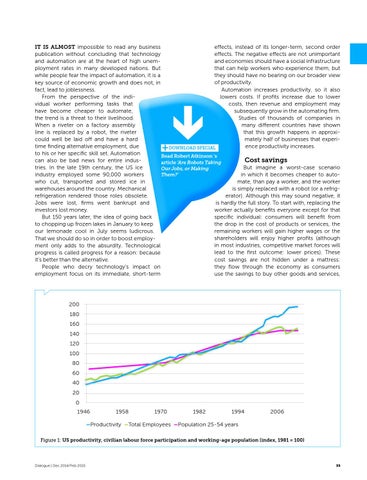effects, instead of its longer-term, second order It is almost impossible to read any business effects. The negative effects are not unimportant publication without concluding that technology and economies should have a social infrastructure and automation are at the heart of high unemthat can help workers who experience them, but ployment rates in many developed nations. But they should have no bearing on our broader view while people fear the impact of automation, it is a of productivity. key source of economic growth and does not, in Automation increases productivity, so it also fact, lead to joblessness. lowers costs. If profits increase due to lower From the perspective of the indicosts, then revenue and employment may vidual worker performing tasks that subsequently grow in the automating firm. have become cheaper to automate, Studies of thousands of companies in the trend is a threat to their livelihood. many different countries have shown When a riveter on a factory assembly that this growth happens in approxiline is replaced by a robot, the riveter mately half of businesses that expericould well be laid off and have a hard ence productivity increases. time finding alternative employment, due DOWNLOAD SPECIAL to his or her specific skill set. Automation Read Robert Atkinson ‘s Cost savings can also be bad news for entire indusarticle ‘Are Robots Taking But imagine a worst-case scenario tries. In the late 19th century, the US ice Our Jobs, or Making Them?’ in which it becomes cheaper to autoindustry employed some 90,000 workers mate, than pay a worker, and the worker who cut, transported and stored ice in is simply replaced with a robot (or a refrigwarehouses around the country. Mechanical erator). Although this may sound negative, it refrigeration rendered those roles obsolete. is hardly the full story. To start with, replacing the Jobs were lost, firms went bankrupt and worker actually benefits everyone except for that investors lost money. specific individual: consumers will benefit from But 150 years later, the idea of going back the drop in the cost of products or services, the to chopping up frozen lakes in January to keep remaining workers will gain higher wages or the our lemonade cool in July seems ludicrous. shareholders will enjoy higher profits (although That we should do so in order to boost employin most industries, competitive market forces will ment only adds to the absurdity. Technological lead to the first outcome: lower prices). These progress is called progress for a reason: because cost savings are not hidden under a mattress: it’s better than the alternative. they flow through the economy as consumers People who decry technology’s impact on use the savings to buy other goods and services, employment focus on its immediate, short-term
+
200 180 160 140 120 100 80 60 40 20 0 1946
1958
1970
1982
1994
2006
–Productivity –Total Employees –Population 25-54 years Figure 1: US productivity, civilian labour force participation and working-age population (index, 1981 = 100)
Dialogue | Dec 2014/Feb 2015
35
